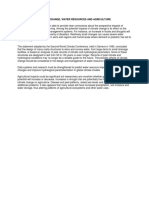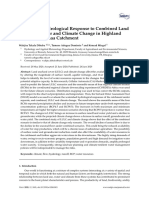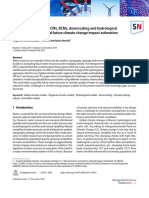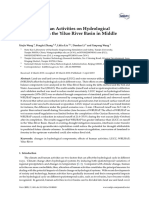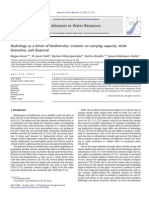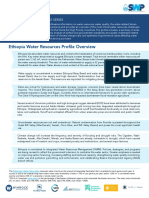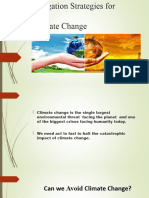Factsheet Ecra CP CHC
Factsheet Ecra CP CHC
Uploaded by
nadiaCopyright:
Available Formats
Factsheet Ecra CP CHC
Factsheet Ecra CP CHC
Uploaded by
nadiaOriginal Description:
Original Title
Copyright
Available Formats
Share this document
Did you find this document useful?
Is this content inappropriate?
Copyright:
Available Formats
Factsheet Ecra CP CHC
Factsheet Ecra CP CHC
Uploaded by
nadiaCopyright:
Available Formats
Prepared for the ECRA General Assembly
7-8 March 2017 | Brussels, Belgium
ECRA Collaborative Programme
Changes in the Hydrological Cycle
Changes in the hydrological cycle and vulnerable regions
The global hydrological cycle is composed of many different and interconnected elements, which include
evaporation from water surfaces and bare soil, evapotranspiration from vegetated land, transport of water
vapour in the atmosphere, cloud droplet formation and cloud dynamics, liquid and solid precipitation,
glaciers and snow cover dynamics, surface and river runoff, and subsurface processes such as root dynamics
in vegetation and groundwater flow. The different components of the hydrological cycle react in complex,
dynamic and often non-linear ways to climate change, sometimes leading to an amplification of the initial
change, sometimes giving rise to negative feedbacks. While hydrological impacts of climate change – such
as spatial and temporal alterations in water balance, streamflow and extreme events (floods, droughts) –
typically occur at regional or local scales, they can initiate modifications that lead to larger-scale or even
global changes in the water cycle. All scales are interconnected.
This Collaborative Programme fosters the study of changes in the hydrological cycle and its impacts at
global and regional scales and generally aims at improving the scientific understanding of hydrological
processes under modified climatic boundary conditions. It places a focus on regions with an already
experienced or expected vulnerability to climate variability and change, such as the Mediterranean and
mountain areas, and addresses the ecological and socioeconomic challenges that are related thereto.
Key topics for ECRA – Changes in the Hydrological Cycle
Performance and limitations of numerical models
Representation of processes in the models and their process-oriented evaluation
Uncertainty in precipitation, one of the most difficult variables of the water cycle to observe and model
Societal challenges related to studying impacts of changes in components of the hydrological cycle
Identification of climate hotspot regions, such as the Mediterranean and the global mountains
Recommendations for research priorities in H2020 and beyond
Focus on climate-hydro interface
In the last decades, the impact of climate change on the water cycle has been increasingly studied,
owing to new modelling frameworks operating in downscaling and upscaling modes. These have the
capability of addressing scaling issues and coupling feedback mechanisms operating at multiple
scales. Some technical questions arising at the climate and hydrology interface include: the role of
observations and reference data, the appropriate downscaling approach for the variable at hand, bias-
correction methods, the quantification of uncertainties across different scales and methodologies to
reduce them.
New key topics: the Earth’s Critical Zone
One of the less studied aspects of the water cycle concerns the Earth’s Critical Zone (ECZ), the veneer
of our planet from the top of the tree canopy to the bottom of drinkable water aquifers where most
life supporting processes occur. Research on ECZ is perforce multi-sectoral and requires
interdisciplinarity. It includes the potential influence of paleo-evolution on ECZ ecosystem functions,
the response of the ECZ to perturbations such as climate and land use changes, possible benefits of
integrating new sensing technology and models for the simulation of essential terrestrial variables, and
safeguarding and managing ECZ services.
Impact-oriented research
A lack of water for drinking, agriculture, industry and energy production can impose risks for civil
security. Therefore, it is important to assess and predict possible changes in water availability,
distribution, and quality. Research needs to be impact-oriented in order to respond to crucial societal
challenges resulting from changes in different components the hydrological cycle and to support
adaptation and risk mitigation strategies. The appropriate context for adopting this approach is one of
collaboration between scientists including hydrologists, social scientists and economists.
Modelling framework: a downscaling chain and related uncertainties
A scale mismatch still exists between the typical spatial resolution of global (70-100 km) and regional
(10-40 km) climate models as well as eco-hydrological and impact models (mostly well below 1 km) to
represent the response of a given variable to climatic forcing or atmosphere-surface interactions. The
scale gap can be bridged through statistical and/or stochastic downscaling methods. While the
reliability of both models and downscaling techniques has considerably improved, the cascade of
uncertainty from climate to impact and hydrological modelling has not been systematically
accounted for. The uncertainty quantification and reduction and its correct communication to the
target audience are of primary importance for better understanding and predicting changes in the
hydrological cycle and possible impacts on water resources.
Focus on specific regions/ecosystems/natural laboratories
Regions that respond more rapidly and intensely to climatic changes and anthropogenic pressures
often provide essential goods to human societies. Therefore, it is crucial to focus research efforts on
vulnerable areas (mountain regions, coastal areas, natural parks, etc.) because their degradation can
cause serious threats to ecosystems, habitat degradation, risk of collapse and loss of ecosystem
services.
Coordinators
Elisa Palazzi (National Research Council (CNR), Italy): e.palazzi@isac.cnr.it
Ralf Ludwig (Ludwig Maximilian University of Munich (LMU), Germany): r.ludwig@lmu.de
Photo credits: pixabay.com
You might also like
- LIBRO - Exploration and Mining Geology W Peters 1978 PDFDocument711 pagesLIBRO - Exploration and Mining Geology W Peters 1978 PDFJaime Renato Abanto Novoa92% (12)
- Drainage System in HighwaysDocument11 pagesDrainage System in HighwaysAtish Kumar92% (12)
- Thesis On Climate Change and Water ResourcesDocument5 pagesThesis On Climate Change and Water Resourcesbk1hxs86100% (2)
- ClImate Change Impacts On Water ResourcesDocument13 pagesClImate Change Impacts On Water Resourcesbulbul chatterjeeNo ratings yet
- Majone AlpSprFest2013Document25 pagesMajone AlpSprFest2013ivanmx09No ratings yet
- The Impacts of Climate Change and Urbanization On Drainage in Helsingborg, SwedenDocument14 pagesThe Impacts of Climate Change and Urbanization On Drainage in Helsingborg, SwedenPlutus PHNo ratings yet
- Climate Change, Water Resources and AgricultureDocument1 pageClimate Change, Water Resources and AgricultureAbdallatef NsourNo ratings yet
- The Effectiveness of SuDS Measures in Reducing TheDocument7 pagesThe Effectiveness of SuDS Measures in Reducing ThetharinduNo ratings yet
- Climate Change and Its Impact On GroundwDocument18 pagesClimate Change and Its Impact On GroundwSABIR AliNo ratings yet
- Water 15 02342Document4 pagesWater 15 023428834: Shanthanagowda GmNo ratings yet
- Watershed Hydrological ResponsDocument26 pagesWatershed Hydrological ResponsBerihunMmanayeNo ratings yet
- Water Resources Engineering Thesis TopicsDocument9 pagesWater Resources Engineering Thesis Topicskarawebberoverlandpark100% (3)
- Climate Change Impact Assessment On Urban Rainfall Extremes and Urban Drainage Methods and ShortcomingsDocument13 pagesClimate Change Impact Assessment On Urban Rainfall Extremes and Urban Drainage Methods and ShortcomingsM Abul Hassan AliNo ratings yet
- Evaluation of Changes On Flood FrequencyDocument16 pagesEvaluation of Changes On Flood FrequencyOtoma OrkaidoNo ratings yet
- CVAEDocument18 pagesCVAEMay Ann GregorioNo ratings yet
- Evaluation of The Impacts of Climate ChaDocument25 pagesEvaluation of The Impacts of Climate ChaEBA AJEMANo ratings yet
- Referencia 9Document40 pagesReferencia 9Mariana VerjanNo ratings yet
- Adaptation of Water Management To Regional Climate Change in A Coastal PDFDocument12 pagesAdaptation of Water Management To Regional Climate Change in A Coastal PDFyiourchNo ratings yet
- Multimodel Assessment of Water Scarcity Under Climate ChangeDocument6 pagesMultimodel Assessment of Water Scarcity Under Climate Changeይቴ ስንሻዉNo ratings yet
- Developing and Demonstrating Climate Indicators FoDocument19 pagesDeveloping and Demonstrating Climate Indicators FoRubio CarmenNo ratings yet
- Chok Kava Rap U 2019Document15 pagesChok Kava Rap U 2019Karan GuptaNo ratings yet
- Impact of Climate Change On Water Resources in The Kilombero Catchment in TanzaniaDocument28 pagesImpact of Climate Change On Water Resources in The Kilombero Catchment in Tanzaniaelinamy moshyNo ratings yet
- Finals HydroDocument4 pagesFinals HydroJaze VillanuevaNo ratings yet
- WaterDocument22 pagesWaterይቴ ስንሻዉNo ratings yet
- Environmental HydrologyDocument8 pagesEnvironmental Hydrologyhannah AyengNo ratings yet
- Climate Change and It's Impact On Water ResourcesDocument19 pagesClimate Change and It's Impact On Water ResourcesSaiteja JumbidiNo ratings yet
- Articulo 9Document15 pagesArticulo 9CAMILO LINDARTENo ratings yet
- Recent AdvancesDocument7 pagesRecent AdvancesSayantan GangulyNo ratings yet
- Jones 2006Document11 pagesJones 2006renzo quevedoNo ratings yet
- Met 1304Document12 pagesMet 1304egidioNo ratings yet
- PHD OpportunityDocument3 pagesPHD OpportunityADAMU GAMBONo ratings yet
- Impact of Climate Change On Hydropower Generation in Rio Jubones Basin, EcuadorDocument10 pagesImpact of Climate Change On Hydropower Generation in Rio Jubones Basin, EcuadorWaldo LavadoNo ratings yet
- Climate Change Prediction and Adaptation in EcohydraulicsDocument5 pagesClimate Change Prediction and Adaptation in Ecohydraulicsandre talNo ratings yet
- Impacts of Climate Change On Moroccan's Groundwater Resources State of Art and Development ProspectsDocument7 pagesImpacts of Climate Change On Moroccan's Groundwater Resources State of Art and Development ProspectschemirikcameliaNo ratings yet
- ADRIANODocument21 pagesADRIANORajabu HatibuNo ratings yet
- Climate Change Adaptation ThesisDocument4 pagesClimate Change Adaptation Thesismaggieturnerdesmoines100% (2)
- Sustainability 14 15438Document20 pagesSustainability 14 15438mekdemNo ratings yet
- Chapter 8 Part 1Document52 pagesChapter 8 Part 1acrechberezangNo ratings yet
- Review: The Influence of Global Change On Europe 'S Water Cycle and Groundwater RechargeDocument21 pagesReview: The Influence of Global Change On Europe 'S Water Cycle and Groundwater Rechargelouis botheNo ratings yet
- Appendix 4: Project 4: Stream EcologyDocument65 pagesAppendix 4: Project 4: Stream EcologySofiDuendeNo ratings yet
- Hydrology 08 00157Document14 pagesHydrology 08 00157gis qgisNo ratings yet
- Hydrology 11 00045 - TardeDocument24 pagesHydrology 11 00045 - TardeMARIA SANTOSA RAMOS ROCANo ratings yet
- Climate Change Impact On Land Degradation and Desertification in The European Mediterranean Region The Role of The International CooperationDocument23 pagesClimate Change Impact On Land Degradation and Desertification in The European Mediterranean Region The Role of The International CooperationfarhanNo ratings yet
- Global Water ResourcesDocument7 pagesGlobal Water ResourcesAlessander Leyendecker JuniorNo ratings yet
- Water Quality Models PDFDocument53 pagesWater Quality Models PDFRamces SolimanNo ratings yet
- Hydrology Aspect of Water SupplyDocument19 pagesHydrology Aspect of Water SupplyJoenem AbenojaNo ratings yet
- Courses NTADocument27 pagesCourses NTAchanderkumarsinghNo ratings yet
- Wetlands and Climate Change Consideratons For Wetland Program Managers 0715Document11 pagesWetlands and Climate Change Consideratons For Wetland Program Managers 0715Eustache NIJEJENo ratings yet
- Teza de Abilitare Halbac-Cotoara-Zamfir RaresDocument102 pagesTeza de Abilitare Halbac-Cotoara-Zamfir RaresAtholosNo ratings yet
- Climate Change ImpactsDocument8 pagesClimate Change Impactskundayi shavaNo ratings yet
- Climate Change Adaptation PHD ThesisDocument9 pagesClimate Change Adaptation PHD Thesisaprillaceyjackson100% (2)
- Water 11 00689 v3 PDFDocument15 pagesWater 11 00689 v3 PDFGrace MagbooNo ratings yet
- Water: Water Resource Variability and Climate ChangeDocument7 pagesWater: Water Resource Variability and Climate ChangeMiguel Angel Quispe PuracaNo ratings yet
- Effects of Climate Change-BeaDocument2 pagesEffects of Climate Change-BeaBea JwNo ratings yet
- Environmental Impact of Hydroelectric Power GeneraDocument11 pagesEnvironmental Impact of Hydroelectric Power Generanelsonrichmond995No ratings yet
- Earth 05 00008Document20 pagesEarth 05 00008BerihunMmanayeNo ratings yet
- Advances in Water ResourcesDocument9 pagesAdvances in Water ResourcesErika StefanNo ratings yet
- 2833 Report 1 Methodology and ResultsDocument271 pages2833 Report 1 Methodology and ResultsGOATNo ratings yet
- BG 16 1657 2019 PDFDocument15 pagesBG 16 1657 2019 PDFAnu ParthaNo ratings yet
- Eccles Rohan Final Thesis RedactedDocument260 pagesEccles Rohan Final Thesis RedactedBerihunMmanayeNo ratings yet
- Changes in Climate Extremes Over North Thailand, 1960-2099Document19 pagesChanges in Climate Extremes Over North Thailand, 1960-2099Ashraf RamadanNo ratings yet
- CRD Method 1Document4 pagesCRD Method 1SudharsananPRSNo ratings yet
- A.M.M. Silva, L.B. Sacomani, 2001Document8 pagesA.M.M. Silva, L.B. Sacomani, 2001Fernanda FrançoisNo ratings yet
- The Environment Plays A Significant Role in SupporDocument2 pagesThe Environment Plays A Significant Role in Supporcayla mae carlosNo ratings yet
- Tectonic ReviewDocument25 pagesTectonic ReviewBelle Estal PalajosNo ratings yet
- Unit 6Document4 pagesUnit 6Khánh Linh 25.Thái TrầnNo ratings yet
- Different Fault Lines in The PhilippinesDocument2 pagesDifferent Fault Lines in The PhilippinesBENJAMIN III BIDANGNo ratings yet
- Geo PP2 QuestionsDocument6 pagesGeo PP2 QuestionsBadmind JnrNo ratings yet
- Q4 Summative Test Science 7Document4 pagesQ4 Summative Test Science 7Anna Liza GomezNo ratings yet
- As 3798 2007 Guidelines On Earthworks For Commercial and Residential DevelopmentsDocument49 pagesAs 3798 2007 Guidelines On Earthworks For Commercial and Residential DevelopmentsLeandroNo ratings yet
- 376 - 2020 Hollowed Et Al. - Integrated Modeling To Evaluate Climate Change Impacts On Coupled Social-Ecological Systems in Alaska - ABS401Document18 pages376 - 2020 Hollowed Et Al. - Integrated Modeling To Evaluate Climate Change Impacts On Coupled Social-Ecological Systems in Alaska - ABS401topsywildeNo ratings yet
- Agricultural Water Management: SciencedirectDocument15 pagesAgricultural Water Management: SciencedirectAlbi HilalNo ratings yet
- Parte 2 Uplift, Subsidence, and Volcanism in The Southern Neiva Basin - Influence On Fluvial Deposition in The Miocene PDFDocument22 pagesParte 2 Uplift, Subsidence, and Volcanism in The Southern Neiva Basin - Influence On Fluvial Deposition in The Miocene PDFDenis RuedaNo ratings yet
- Water The Enemy of The Rail TrackDocument39 pagesWater The Enemy of The Rail TrackhanNo ratings yet
- PrecipitationDocument18 pagesPrecipitationAlexandra Shun MandrezaNo ratings yet
- Food Chain, Food Web and Ecological PyramidsDocument32 pagesFood Chain, Food Web and Ecological PyramidsmayankNo ratings yet
- Ethiopia Water Resources Profile OverviewDocument11 pagesEthiopia Water Resources Profile Overviewbantalem100% (1)
- Mitigation Strategies For Climate ChangeDocument13 pagesMitigation Strategies For Climate Changexsrazi100% (1)
- Biotic and Abiotic 1104 LPDocument4 pagesBiotic and Abiotic 1104 LPERLYN NANGITNo ratings yet
- USACE Hydrologic AssessmentDocument44 pagesUSACE Hydrologic AssessmentYapeng ZhaoNo ratings yet
- Khulna, Koyra StudyDocument22 pagesKhulna, Koyra StudyHousing KhulnaNo ratings yet
- Geog Ubd Yr8Document31 pagesGeog Ubd Yr8api-298026161100% (2)
- 07 AGS22 Hoschke (Geophysics) Final - 2Document16 pages07 AGS22 Hoschke (Geophysics) Final - 2muhammad zikraNo ratings yet
- Case Study of A Drainage BasinDocument8 pagesCase Study of A Drainage BasinGrace KamauNo ratings yet
- History of Plate Tectonics Ppt-1Document26 pagesHistory of Plate Tectonics Ppt-1Radin Tagarino100% (1)
- Shadow Zone of P and S WaveDocument1 pageShadow Zone of P and S WavePeter LovanasNo ratings yet
- 01 Lec IntroductionDocument19 pages01 Lec Introductionامين الزريقيNo ratings yet
- Effects of Organic and Inorganic Fertilizers To The Fertility of The Soil Specific QuestionsDocument3 pagesEffects of Organic and Inorganic Fertilizers To The Fertility of The Soil Specific QuestionsCarsen P.No ratings yet
- Geologic Framework For The Tengiz and Korolev Fields, Kazakhstan - Tangiz - Carboniferous Isolated Carbonate PlatformsDocument60 pagesGeologic Framework For The Tengiz and Korolev Fields, Kazakhstan - Tangiz - Carboniferous Isolated Carbonate PlatformsParvez ButtNo ratings yet






